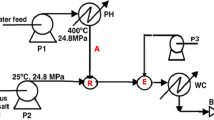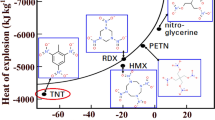Abstract
The current study highlights a sustainable fabrication of nanoscopic thermite (MnO2/Al) system, composed of MnO2 nanoparticles with an average particle size of about 20.8 nm prepared by a hydrothermal processing technique. In addition, it contains aluminium particles having a combustion heat of 32,000 J/g, which is very attractive for advanced energetic systems. Plate-like aluminium nanoparticles with an average particle size of 100 nm were developed by wet milling. Our results revealed aluminium optimum solid loading in tri-nitrotoulene (TNT), which was found to be 8.0 wt%. At this optimum solid loading level, aluminium nanoparticles increased the destructive effect of TNT by 25.0%. While, stoichiometric colloidal mixture of both MnO2 and Al nanoparticles exhibited a 65.0% increase in the destructive effect of TNT. Our work presents an intimate mixing between nano-thermite particles, where particle size and inter-particles’ distance are at the nanoscale. To sum up, TNT detonation wave was supported with one of the most potent thermite reactions occurring with maximum rate.






Similar content being viewed by others
References
H. Ritter, S. Braun, High explosives containing ultrafine aluminum ALEX. Propellants Explos. Pyrotech. 26(6), 311–314 (2001)
N.H. Yen, L.Y. Wang, Reactive metals in explosives. Propellants Explos. Pyrotech. 37(2), 143–155 (2012)
R.C. Doty et al., Extremely stable water-soluble Ag nanoparticles. Chem. Mater. 17(18), 4630–4635 (2005)
V.E. Zarko, A.A. Gromov, Energetic Nanomaterials Synthesis, Characterization, and Application (Elsevier, Amsterdam, 2016)
P.P. Vadhe et al., Cast aluminized explosives (review). Combust Explos Shock Waves 44(4), 461–477 (2008)
J. Conkling, C. Mocella, Chemistry of Pyrotechnics Basic Principles and Theory, Second. (CRC, London, 2012)
M.L. Chan et al., Castable thermobaric explosive formulations. 2005, The United State of America Repredented by The Secretary of The Navy: United States. p. 5
W.A. Trzciński, L. Maiz, Thermobaric and enhanced blast explosives—properties and testing methods. Propellants Explos. Pyrotech. 40, 632 (2015)
L. Shen et al., Preparation and characterization of Al/B/Fe2O3 nanothermites. Sci. China Chem. 57(6), 797–802 (2014)
S. Elbasuney, Novel colloidal nanothermite particles (MnO2/Al) for advanced highly energetic systems. J. Inorg. Organomet. Polym. Mater. 28(5), 1793–1800 (2018)
B.Q. Lin et al., Experimental investigation on explosion characteristics of nano-aluminum powder—air mixtures. Combust. Explos. Shock Waves 46(6), 678–682 (2010)
P. Brousseau, C.J. Anderson, Nanometric aluminum in explosives. Propellants Explos. Pyrotech. 27(5), 300–306 (2002)
E.L. Dreizin, Metal-based reactive nanomaterials. Prog. Energy Combust. Sci. 35(2), 141–167 (2009)
H.J. Krier, J.M. Peuker, N. Glumac, Aluminum combustion in aluminized explosives: aerobic and anaerobic reaction, in 49th AIAA aerospace sciences meeting including the new horizons forum and aerospace exposition Orlando, Florida (2011)
A.K. Mohamed, H.E. Mostafa, S. Elbasuney, Nanoscopic fuel-rich thermobaric formulations: chemical composition optimization and sustained secondary combustion shock wave modulation. J. Hazard. Mater. 301, 492–503 (2016)
S. Elbasuney et al., Colloid thermite nanostructure: a novel high energy density material for enhanced explosive performance. J. Inorg. Organometall. Polym. Mater. (2020). https://doi.org/10.1007/s10904-020-01687-3
J. Shin et al., Numerical modeling of close-in detonations of high explosives. Eng. Struct. 81(0), 88–97 (2014)
V.W. Manner et al., The role of aluminum in the detonation and post-detonation expansion of selected cast HMX-based explosives. Propellants Explos. Pyrotech. 37(2), 198–206 (2012)
X.L. **ng et al., Discussions on thermobaric explosives (TBXs). Propellants Explos. Pyrotech. 39(1), 14–17 (2014)
K.L. McNesby et al., Afterburn ignition delay and shock augmentation in fuel rich solid explosives. Propellants Explos. Pyrotech. 35(1), 57–65 (2010)
M.B. Talawar et al., Emerging trends in advanced high energy materials. Combust. Explos. Shock Waves 43(1), 62–72 (2007)
J.P. Agrawal, Status of Explosives. High Energy Materials (Wiley, New York, 2010), pp. 69–161
R. Meyer, J. Kohler, A. Homburg, Explosives, 6th edn. (Wiley, Weinheim, 2007)
M. Suceska, Test methods for explosives (Springer, New York, 1995)
M.M. West, D. Zavitsanos, Composite High Explosives for High Energy Blast Applications (General Electric Co., Philadelphia, 1982), p. 8
F. Maggi et al., Activated aluminum powders for space propulsion. Powder Technol 270, 46–52 (2015)
G. Jian et al., Nanothermite reactions: is gas phase oxygen generation from the oxygen carrier an essential prerequisite to ignition? Combust. Flame 160(2), 432–437 (2013)
D. Moradkhani, M. Malekzadeh, E. Ahmadi, Nanostructured MnO2 synthesized via methane gas reduction of manganese ore and hydrothermal precipitation methods. Trans Nonferrous Met Soc China 23(1), 134–139 (2013)
L. Kang et al., Urea-assisted hydrothermal synthesis of manganese dioxides with various morphologies for hybrid supercapacitors. J. Alloys Compd. 648, 190–194 (2015)
S. Elbasuney, Enhanced flame retardant polymer nanocomposites, in school of chemical and environmental engineering 2013, Nottingham: Nottingham. p. 280
S. Elbasuney, Dispersion characteristics of dry and colloidal nano-titania into epoxy resin. Powder Technol. 268(0), 158–164 (2014)
S. Elbasuney, Surface engineering of layered double hydroxide (LDH) nanoparticles for polymer flame retardancy. Powder Technol. 277, 63–73 (2015)
S. Elbasuney, Continuous hydrothermal synthesis of AlO(OH) nanorods as a clean flame retardant agent. Particuology 22, 66–71 (2015)
S. Elbasuney, Sustainable steric stabilization of colloidal titania nanoparticles. Appl. Surf. Sci. 409, 438–447 (2017)
S. Elbasuney, Novel multi-component flame retardant system based on nanoscopic aluminium-trihydroxide (ATH). Powder Technol. 305, 538–545 (2017)
K. Byrappa, S. Ohara, T. Adschiri, Nanoparticles synthesis using supercritical fluid technology – towards biomedical applications. Adv. Drug Deliv. Rev. 60(3), 299–327 (2008)
S. Elbasuney, S.F. Mostafa, Continuous flow formulation and functionalization of magnesium di-hydroxide nanorods as a clean nano-fire extinguisher. Powder Technol. 278, 72–83 (2015)
K. Byrappa, M. Yoshimura, Handbook of hydrothermal technology (William Andrew, Norwich, 2001)
J. Li, Engineering Nanoparticles in Near-Critical and Supercritical Water (University of Nottingham, Nottingham, 2008)
P. Savage et al., Reactions at supercritical conditions: applications and fundamentals. Am. Inst. Chem. Eng. (AIChE) J. 41(7), 1723–1778 (1995)
H. Hobbs, Biocatalysis in ‘Green Solvents’, Chemistry (University of Nottingham, Notttingham, 2006)
J.A. Darr, M. Poliakoff, New directions in inorganic and metal-organic coordination chemistry in supercritical fluids. Chem. Rev. 99(2), 495–541 (1999)
K.S. Morley et al., Clean preparation on nanoparticulate metals in porous supports: a supercritical route. J. Chem. Mater. 12, 1898–1905 (2002)
J.B. Dunn, D.I. Urquhart, P.E. Savage, Terephthlic acid synthesis in supercritical water. Adv. Synth. Catal. 344(3–4), 385–392 (2002)
T. Adschiri, Y. Hakuta, K. Arai, Hydrothermal synthesis of metal oxide fine particles at supercritical conditions. Ind. Eng. Chem. Res. 39(12), 4901–4907 (2000)
T. Adschiri, K. Kanazawa, K. Arai, Rapid and continuous hydrothermal synthesis of boehmite particles in subcritical and supercritical water. Am. Ceram. Soc. 75(9), 2615–2618 (1992)
M. Sućeska, Evaluation of detonation energy from EXPLO5 computer code results. Propellants Explos. Pyrotech. 24(5), 280–285 (1999)
M. Sućeska, Calculation of the detonation properties of C-H-N-O explosives. Propellants Explos. Pyrotech. 16(4), 197–202 (1991)
S. Elbasuney et al., Stabilized super-thermite colloids: a new generation of advanced highly energetic materials. Appl. Surf. Sci. 419, 328–336 (2017)
A.I. El-Batal et al., Response surface methodology optimization of melanin production by streptomyces cyaneus and synthesis of copper oxide nanoparticles using gamma radiation. J. Cluster Sci. 28(3), 1083–1112 (2017)
M. Abd Elkodous et al., Therapeutic and diagnostic potential of nanomaterials for enhanced biomedical applications. Colloids Surf. B 180, 411–428 (2019)
M.A. Elkodous et al., Layer-by-layer preparation and characterization of recyclable nanocomposite (CoxNi1–xFe2O4; X = 0.9/SiO2/TiO2). J. Mater. Sci.: Mater. Electron. 30(9), 8312–8328 (2019)
M.A. Maksoud et al., Synthesis and characterization of metals-substituted cobalt ferrite [Mx Co (1–x) Fe2O4;(M = Zn, Cu and Mn; x = 0 and 0.5)] nanoparticles as antimicrobial agents and sensors for Anagrelide determination in biological samples. Mater. Sci. Eng. C 92, 644–656 (2018)
A. Ashour et al., Antimicrobial activity of metal-substituted cobalt ferrite nanoparticles synthesized by sol–gel technique. Particuology 40, 141–151 (2018)
M.A. Maksoud et al., Tunable structures of copper substituted cobalt nanoferrites with prospective electrical and magnetic applications. J. Mater. Sci.: Mater. Electron. 30(5), 4908–4919 (2019)
R.J. Gohari et al., Improving performance and antifouling capability of PES UF membranes via blending with highly hydrophilic hydrous manganese dioxide nanoparticles. Desalination 335(1), 87–95 (2014)
J.-G. Wang et al., Incorporation of nanostructured manganese dioxide into carbon nanofibers and its electrochemical performance. Mater. Lett. 72, 18–21 (2012)
B.G.S. Raj et al., Sonochemically synthesized MnO2 nanoparticles as electrode material for supercapacitors. Ultrason. Sonochem. 21(6), 1933–1938 (2014)
C. Mandilas et al., Synthesis of aluminium nanoparticles by arc plasma spray under atmospheric pressure. Mater. Sci. Eng. B 178(1), 22–30 (2013)
M. Paskevicius et al., Mechanochemical synthesis of aluminium nanoparticles and their deuterium sorption properties to 2 kbar. J. Alloys Compd. 481(1–2), 595–599 (2009)
B. Alinejad, K. Mahmoodi, A novel method for generating hydrogen by hydrolysis of highly activated aluminum nanoparticles in pure water. Int. J. Hydrogen Energy 34(19), 7934–7938 (2009)
Acknowledgements
Military technical college is acknowledged for funding the research project entitled “Nanoscopic Cast Metalized Explosive Formulations”.
Author information
Authors and Affiliations
Corresponding authors
Ethics declarations
Conflict of interest
The authors declare that they have no conflict of interest.
Additional information
Publisher's Note
Springer Nature remains neutral with regard to jurisdictional claims in published maps and institutional affiliations.
Electronic supplementary material
Below is the link to the electronic supplementary material.
Rights and permissions
About this article
Cite this article
Elbasuney, S., El-Sayyad, G.S., Yehia, M. et al. Novel (MnO2/Al) thermite colloid: an opportunity for energetic systems with enhanced performance. J Mater Sci: Mater Electron 31, 21399–21407 (2020). https://doi.org/10.1007/s10854-020-04653-4
Received:
Accepted:
Published:
Issue Date:
DOI: https://doi.org/10.1007/s10854-020-04653-4




